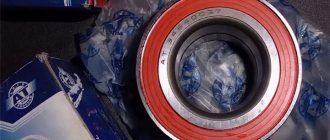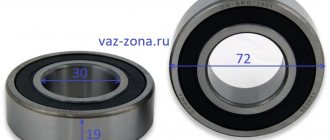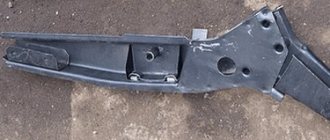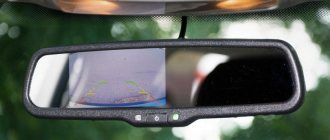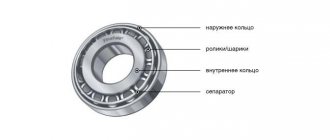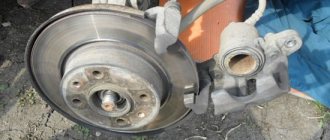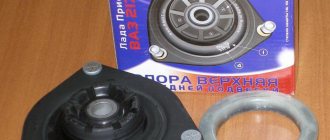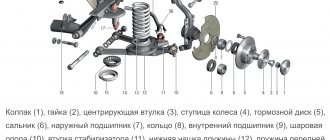Device
In order for the car to move, it is necessary to transfer the rotation of the engine to the wheels. But the engine speed is too high, and in order to correctly distribute the torque, a mechanism is needed that changes the gear ratio. Due to the gearbox and different engine speeds, the speed of movement changes, and the main pair of the rear axle takes over the rotation and transmits it to the wheels through gears.
- flange, it is fixed on the drive gear (shank) of the RZM, and is an intermediate link between the driveshaft and this gear;
- the shank of the main pair, at one end of which there are splines for pressing the flange, at the other end there is a bevel gear with a small number of teeth;
- driven gear (planet gear), it is in mesh with the drive gear, and it is with it that it forms the main gear;
- center differential, allowing the rear wheels to spin at different angular speeds.
The differential design is very simple - the mechanism consists of two axle gears, two satellites and a satellite pin. From the gearbox, the movement is transmitted to the axle shafts, on which the wheels are mounted.
Design and technical characteristics of the gearbox
The rear gearbox of the VAZ 2107 car consists of a massive steel casing with a shank, a driveshaft flange, two main gears mounted at right angles to each other and a self-locking differential.
Rear gear ratio
The main characteristic of any gear transmission is its gear ratio. It is the ratio of the number of teeth on the driven gear to the number of teeth on the drive gear. The driven gear of the VAZ 2107 rear gearbox has 43 teeth. And the drive gear has 11 teeth. Dividing 43 by 11 we get 3.9. This is the gear ratio on the VAZ 2107 gearbox.
Another important point should be noted here. VAZ 2107 was produced for many years. And over the years, gearboxes with different gear ratios were installed on it. For example, the earliest models of the “seven” were equipped with gearboxes from the VAZ 2103, the gear ratio of which was 4.1, that is, the tooth ratio was 41/10. On later “sevens” the gear ratio changed again and was already 4.3 (43/10) and only in the newest “sevens” this number is 3.9. Due to the above reasons, the driver often has to independently determine the gear ratio of his car. Here's how it's done:
- the car is set to neutral gear;
- The rear of the car is raised using two jacks. One of the rear wheels is securely fixed;
- After this, the driver manually begins to turn the driveshaft of the car. It is necessary to make 10 revolutions;
- By rotating the driveshaft, you need to calculate how many revolutions the unfixed rear wheel will make. The number of wheel revolutions should be divided by 10. The resulting number is the gear ratio of the rear gearbox.
Bearings
The rotation of all gears of the gearbox is ensured by bearings. In the rear gearboxes of the VAZ 2107, single-row roller bearings are used on the differential, and the rollers there have a conical shape. Bearing marking is 7707, catalog number is 45–22408936. The price of a bearing on the market today starts from 700 rubles.
Another bearing is installed in the gearbox shank (i.e., in the part that connects to the cardan). This is also a tapered roller bearing marked 7805 and catalog number 6–78117U. Standard VAZ shank bearings today cost from 600 rubles and more.
Planetary pair
The main purpose of the planetary pair in the rear gearbox of the VAZ 2107 is to reduce engine speed. The pair reduces the crankshaft speed by about 4 times, that is, if the engine crankshaft rotates at a speed of 8 thousand rpm, then the rear wheels will rotate at a speed of 2 thousand rpm. The gears in the planetary pair of the VAZ 2107 are helical. This solution was not chosen by chance: a helical gear is almost twice as quiet as a spur gear.
But helical planetary pairs also have a disadvantage: the gears can move along their axes as they wear out. However, this problem is relevant for racing cars, the rear axles of which have exclusively spur gears. And for all the years of production of this car, the VAZ 2107 had exclusively helical planetary pairs.
Differences in VAZ rear axle gearboxes
RZMs differ in the gear ratio of the main pair; in total, there are four types of gearboxes on the VAZ classic:
The slowest one is the RZM 2102, its drive gear has 9 teeth, and the driven gear has 40 teeth. To calculate the gear ratio, you need to divide the number of planetary gear teeth by the number of teeth on the drive shaft; for the VAZ 2102 the drive gear is equal to 4.44.
The “penny” gearbox (2101) accordingly has the number of teeth on the gears 10/43, so its IF is 4.3. The next, faster one is RZM 2103 - it has a ratio of 1041, which means the gear ratio is 4.1. And finally, the “fastest” will be the 2106 gearbox, with the number of teeth 11/43 and an inverter frequency of 3.9, respectively.
Many VAZ 2101-07 owners strive to install the fastest gearbox, but this is not always necessary. If the car often carries cargo, that is, the car is a “workhorse”, high speed is of no use, but high-torque power will be very useful. It should be noted that RZM 2102 was not supplied as spare parts; it was installed only on station wagons.
Replacing the rear axle gearbox of VAZ 2106, 2107
The main disease of REM is increased noise (hum), and the gearbox can hum for various reasons:
- there is insufficient oil in the bridge, or it is completely missing;
- the gap between the gears of the main pair is not adjusted;
- the gears are worn out, they have chips and other damage;
- the main pair has a manufacturing defect, the gears are not ground in from the factory;
- the shank nut has become unscrewed or loosened;
- bearings are worn out.
The main malfunction of the center differential is the wear of the gears of the axle shafts and satellites, when the surfaces of the parts are heavily worn, play forms between the differential gears, but the rear axle usually does not make noise due to wear of the differential gears.
ZM gearboxes on VAZ classics can be repaired, but only if there is no wear on the gears. If the mechanism can no longer be repaired, it needs to be replaced. We replace the rear axle gearbox of a VAZ 2106 on a “seven” as follows:
- we install the car on a pit or a car lift; changing the gearbox on the ground is extremely inconvenient;
- if the car is installed on a pit, it is necessary to jack up both sides; in any case, the rear wheels must be removed. If the work is not done on a lift, you should install stops under each side of the car (in the rear);
- unscrew the drain plug in the REM, drain the transmission oil, having previously prepared a container for it;
- remove the rear brake drums (two guide bolts on each side), after first removing the car from the handbrake. The drums can be difficult to remove; they are dismantled by tapping them from behind with a hammer through a wooden block. You cannot hit the drum with a metal hammer; the drum may break;
- remove the brake pads;
- unscrew the fastenings of the rear axle axle shafts on each side, each axle shaft is secured with four nuts;
- we press out the axle shafts, for this you will need a special puller, you can also make a homemade device;
- remove the driveshaft by unscrewing the four bolts and nuts. If the same REM is installed, the cardan with the shank must be marked; this is done in order to put the shaft back in the same position. If you install the cardan incorrectly according to the marks, the shaft may begin to vibrate;
- unscrew the eight bolts securing the rear gearbox (key 13), remove the assembly.
At this point, the removal of the gearbox can be considered complete; now all that remains is to either repair the mechanism or install a new one instead.
How to replace it yourself: step-by-step instructions
Replacing the rear axle gearbox oil seal on a VAZ 2107
The procedure for replacing a household regulator is not particularly difficult and is quite accessible for you to do it yourself. However, for people who do not have any training, it is recommended that they first familiarize themselves with the rules for performing such work and study the procedure.
Until you are confident in a positive result, you should not proceed with replacement, otherwise you could flood your apartment (both yours and the neighbors below), as well as leave the whole family without hot or cold water.
approximate cost
When performing a replacement yourself, the cost depends only on the cost of the device.
The price of a household regulator can range from 800 to 16,000 rubles (most household regulators cost between 800-2000 rubles).
Based on this price range and your own financial capabilities, you can make a rough estimate of your expenses.
It is recommended to buy a gearbox equipped with a pressure gauge. Such models are more expensive, but they allow you to see the current water pressure and determine whether the device responds to changes in the system.
Tools and materials
No special tools are required to replace the gearbox. You need to prepare:
- adjustable wrench;
- set of sanitary winding (FUM tape or flax, Unipak paste);
- new replacement gearbox;
- a bucket of water for washing the filter and other assembly elements.
If you plan to clean the water filter along with replacing the gearbox (it is recommended to do this, since a clogged filter is not able to do its job), a metal brush will come in handy.
With its help, the cylindrical mesh is cleaned and plaque with solid particles is removed.
Process
It is recommended to change both devices at once - hot and cold water. This will make it possible to determine the service life and determine which of them works in more difficult conditions.
Procedure:
- Turn off the water.
- Open one of the taps located after the entrance group to drain the remaining water from the pipe.
- Using a wrench, unscrew the union nuts on the old gearbox. Sometimes you have to use two wrenches, one of which holds the threaded part motionless, and the second one unscrews the nut.
- Having completely freed the union nuts, remove the gearbox from the assembly.
- Using a 30 mm spanner, unscrew the coarse filter nut.
- Take out the mesh element, wash it in water and clean it of dirt using a metal brush.
- Reassemble the filter in reverse order.
- Install a new gearbox. Care must be taken to ensure correct installation. The direction of flow is indicated by an arrow on the body.
- All connections are sealed using FUM tape or flax.
- Let the water run and check for leaks.
- Configure the device (according to the attached instructions).
There are gearbox models whose design also contains a built-in coarse filter. They must be periodically cleaned of dirt so that the operating mode of the device is not disrupted.
Adjusting the VAZ rear axle gearbox
If the main pair in the gearbox is worn out, it must be replaced. But you can’t just put the gears back in place; the gaps in them must be adjusted. In total, two types of basic adjustments are made:
- The thickness of the adjusting sleeve (washer) is selected for the shank (drive gear). The washer can have a thickness from 2.6 mm to 3.5 mm;
- The gap between the gears of the main pair is adjusted using two adjusting nuts of the differential housing.
The washer for the shank is selected in such a way that the shaft with the drive bevel gear rotates in the gearbox housing without backlash with a force by hand (0.3-0.4 kg). In this case, the shank nut should be tightened with a force of 12 to 26 kg, usually 18-19 kg are tightened.
After installing the shank, the differential housing with the planetary gear attached to it is put in place. The housing is secured with two covers (4 bolts, a knob with a 17mm head). The adjusting nuts are tightened from the sides of the bearings, the differential is installed so that there is play between the gears of the main pair, and the planetary gear should not be clamped. By moving the adjusting nuts to the right and left, the shank gear is brought to the planetary gear. By adjusting, you select the moment when the gap between the gears practically disappears.
The last stage is to adjust the preload of the differential bearings; the adjusting nuts are tightened from the sides. This work must be done with an indicator; the device should show from 0.14 to 0.18 mm, the gap between the gears should be within 0.08-0.13 mm. After the operation, the adjusting nuts are fixed with plates so that they do not turn.
It should be noted that adjusting the VAZ rear axle gearbox is a very difficult matter, and it is better to trust it to professionals.
How to make repairs
To begin, remove the gearbox from the machine, and then clamp it into a clamp. Unscrew both bolts for the locking plates and remove them.
Next, the bearing caps are marked for their future assembly. To do this, you will need a center punch and use a hammer to make marks. Use wrench No. 14 to unscrew the bolts and remove the covers.
It is important to immediately inspect the bearings for wear and serviceability. The outer races from each bearing are marked, since they are selected in pairs and cannot be disassembled
The radial play located on the axle gears is checked. If its size exceeds 0.5 mm, then the box is replaced. In normal condition, the bearing is removed and the planetary gear is unscrewed.
Next, you need to knock out the satellite axis using the adapter and pull them out.
You need to remove the drive shaft and gear from the gearbox housing. A soft metal punch is perfect for this. The inner wheel of the roller bearing is knocked out.
It is also necessary to replace the adjusting sleeve with a new one.
After knocking down the bearing, you need to remove the adjustment ring.
Next, use a drift to knock out the outer rings of the bearings.
Now you can wash all parts in kerosene or diesel fuel. After the washing is done, all parts are diagnosed. There should be no chips or cracks
If these defects are present, it is important to replace the parts. If there are small scratches, they can be polished with sandpaper.
Repair or replacement, which is better?
Car owners of VAZ classics often cannot decide what is best to do - buy a complete ready-made REM assembled or purchase individual parts and repair the gearbox. It’s really difficult to decide here - the price of a new gearbox, of course, is higher, but the owner of the car is freed from the headache of adjustment. The thing is that it’s not so easy to find a good specialist in VAZ gearboxes, and there is no guarantee that the new main pair will not hum.
If a car owner buys a new gearbox, but it hums, the part can be exchanged under warranty, but the car owner loses money on removing and installing the gearbox. If you purchase a defective main pair, the repair itself will be more expensive - you will have to pay a technician for a secondary overhaul of the gearbox.
Self-locking differential
The most common way to increase a car's cross-country ability is to install a self-locking differential. The main advantage of this device is that it prevents wheel locking “forever”. This is important because preventing lockup from engaging when not required helps protect the axle shafts from critical loads.
There are the following types of differential locks:
- Disc - implemented through the use of friction clutches. These clutches come into action as soon as the wheels begin to rotate at an uneven speed. The disadvantage of this mechanism is that it requires the use of expensive gear oil, and also requires quite frequent adjustment work to set up the unit. This is far from the best mechanism for a VAZ 2107 car.
- Viscous coupling blocking - the operation of such a device is based on the use of sticky discs immersed in a special liquid. It hardens when heated, allowing the gears to engage—that is, the differential locks. The liquid heats up when the angular speed of the wheels on the axle changes (when the speed of rotation of the wheels becomes different). The disadvantage of this mechanism is that they require complete sealing of the assembly, and work effectively only during short-term slipping.
- Screw locking or worm locking is the best option for automatic locking for the VAZ 2107. The mechanism is implemented using worm screws, which rotate when the car drives in a straight line, and when the angular speed of the wheels changes, they shift into grooves, thereby locking the differential. As soon as the car gets out of the mud captivity, the blocked mechanism resumes its normal operation by moving the worm screws to their places.
- Planetary - the operating principle is similar to a worm circuit, only instead of gears, balls are used. Due to the balls, the wheels are blocked, and they come into operation when the traction force between the engines and the axle changes. Compared to a self-locking worm gearbox, a planetary gearbox costs about 2 times less.
In addition to automatic differential locking, there is also a forced one, which is activated if necessary.
VAZ rear axle gearbox locking
On VAZ 2101-07 vehicles, the factory does not provide locking of the center differential, but the industry already produces both differentials with locks and fully assembled 3M gearboxes. The most common today are REMs with screw locking; in them, the differential gears are locked depending on the load. In such rear axle gearboxes, a preload clutch is installed, it connects the wheel axle shafts with a certain force, and acts as a blocker.
Locking the VAZ rear axle gearbox provides the following advantages:
- increases cross-country ability, allows the vehicle to avoid slipping on difficult road sections;
- allows the car to accelerate faster at the start;
- The car corners more confidently.
But ZM gearboxes with screw locking also have their disadvantages:
- Fuel consumption increases slightly;
- when accelerating, the car handles worse;
- The differential and assembled gearbox with locking are much more expensive than standard parts (the price is approximately 2-2.5 times higher).
VAZ 2101-07 car owners should know that after installing the RZM with blocking, the car will not become an SUV, and it will not be able to move on severe off-road conditions.
Can't you spoil the porridge with oil?
Oil is poured into the axle housing up to the lower edge of the filler hole, in the position when the axle is installed and secured to the vehicle. You should not fill oil above this level, since a larger volume significantly increases power loss when the gears rotate and provokes leaks.
Lubrication of gearbox parts occurs as follows. The lower part of the driven wheel and differential are constantly immersed in an oil bath. When the car moves, they rotate, alternately wetting with oil all the teeth of the main gear and differential gears. The differential bearings and the rear pinion bearing are lubricated in the same way. In addition, the teeth of the driven wheel spray oil abundantly, creating “oil mist” in the crankcase. The least amount of oil when splashed goes to the front, most distant, bearing of the drive gear. To lubricate it, a channel is made in the upper part of the crankcase, where, under the influence of centrifugal force, oil is thrown from the outer circumference of the driven wheel. The higher the rotation speed, the more oil enters the channel. This channel leads into the cavity between the bearings of the drive gear, passes through the bearings and returns to the bridge beam. To drain oil from the flange side of the drive gear, there is an oil drain channel in the crankcase. The bearings, due to the conical shape of the rollers, have a pronounced pumping effect, so the flow of oil that flows from the front bearing directly to the oil seal can be quite significant - more than one liter per minute. It is not easy to withstand such pressure, so an oil-removing washer is installed immediately behind the bearing, in front of the oil seal. It slows down the flow rate, but there is still a gap between it and the crankcase through which the oil flows to the oil seal. Therefore, the tightness of the drive gear oil seal is a constant concern for axle designers and manufacturers.
The amount of oil supplied to the oil seal depends on the speed of rotation of the driven wheel of the final drive
But the lack of oil supplied to the oil seal is no less, and perhaps even more harmful to its “health”, because with dry friction against the surface of the flange, no matter how smooth it may be in appearance, the working edge of the oil seal will wear out very quickly, and a gap will form between it and the shaft, through which not only oil can flow out, but also water can flow in if you need to cross a ford or just a deep puddle in a heavy downpour. And water in oil is a very quick “death” for gears and bearings.
Malfunctions of the rear axle of VAZ 2101, 2102, 2103, 2104, 2105, 2106, 2107 cars
Increased noise from the rear wheels
— The wheel mounting bolts are loose
The bolts need to be tightened.
— Wear or destruction of the axle bearing
The axle bearing needs to be replaced.
Constant increased noise from the rear axle
— The rear axle beam is deformed
Replace the rear axle stockings or the entire axle.
We replace bent axle shafts with new ones.
— Wear of splines on axle shafts
— The rear axle gearbox is incorrectly adjusted, its gears or bearings are damaged or worn
The gearbox needs to be repaired or replaced.
— Not enough oil in the rear axle
Bring the level to normal, eliminate leakage.
Noise when accelerating a car
— Shock absorbers are faulty
Check and replace shock absorbers.
— Incorrectly adjusted gearing of the main gears after gearbox repair
Adjust the engagement by selecting the drive gear adjusting ring.
— Damaged axle bearing
— Not enough oil in the rear axle
Bring the level up to normal.
Noise when the car engine brakes
— Incorrect lateral clearance in the mesh between the final drive gears
Disassemble the gearbox and set the gap to 0.08 - 0.13 mm.
— Increased clearance in the drive gear bearings due to loosening of the flange nut or wear of the bearings
It is necessary to check the technical condition and moment of resistance to rotation of the drive gear.
Noise when accelerating and braking the car engine
— Wear or destruction of drive gear bearings
They need to be replaced.
— There is no lateral clearance between the teeth of the main gear gears
Disassemble the gearbox and set the gap between the teeth to 0.08 - 0.13 mm.
Noise when cornering
— Tight rotation of the satellites on the axis
Disassemble the differential, replace damaged and deformed parts.
Disassembling the unit
To disassemble the gearbox, you will need to do the following:
- Unscrew the shank securing nut.
- Remove the flange, then remove the drive gear along with the adjusting rings.
- Remove the oil seal, inner race on the bearing and oil deflector.
- Using a puller, remove the outer rings from the bearings.
- Disassemble the drive gear along with the differential mechanism. Subsequently, the spacer sleeve must be replaced.
When disassembling the mechanism, be sure to mark the bearing caps so that they can be installed in the same way during reassembly. It is recommended to use a pencil or core to make marks. Label the right and left covers to avoid confusion during installation. It is advisable to mark these covers using a core.
Using a drift and a hammer, you need to remove the separator and the inner rings. Please note that you should not knock too hard. The rings are knocked out by lightly tapping in a circle. If you hit only one point, the ring will not come out. When repairing a rear gearbox, the bearings or the main pair are usually replaced. These are the most vulnerable elements of the system.
What is an axle reducer?
The rear axle gearbox is a set of mechanisms designed to transmit the torque of the propeller shaft to the axles of the rear wheels. To understand that it requires a gearbox, you need to know how the engine energy is transferred to the wheels of the car.
During operation, the rotation of the engine crankshaft is transmitted to the vehicle's clutch disc, and then to the input shaft of the gearbox. The gear selected by the driver transmits rotation to the output shaft of the gearbox, and then to the crosspiece of the driveshaft, which extends under the car to the rear axle gearbox. The rear axle gearbox distributes torque from the driveshaft to the axle shafts, which, in turn, drive the wheels. Thus, the rear axle gearbox is designed to convert the torque of the propeller shaft to the two axle shafts of the rear wheels of the car.
Diagnostics and causes of malfunctions
The fact that the gearbox is in a faulty condition is indicated by the appearance of a characteristic noise (hum) when the vehicle is moving. To accurately determine the gearbox malfunction, there is the following experiment.
You need to accelerate the car to 25 kilometers per hour and gradually pick up speed, starting from this mark. If suspicious hums appear, be sure to record the speed at which you hear them.
Once you reach the desired speed, slowly release the gas pedal and apply engine braking. Again, listen for extraneous noises and pay attention to the speed at which they appear or disappear.
Certain noises should appear and disappear at the same speed. If this happens, it means that the rear axle gearbox is in a faulty condition. However, to be 100 percent sure, be sure to put the car on the parking brake, put the gear in neutral and try to gain speed, if the noise appears again, then the problem is not in the rear axle gearbox, and if there is no noise, then you can be sure that it is rear axle gearbox.
The cause of malfunctions, most often, lies in the use of low-quality oil, loss of its viscosity, as well as its complete absence. In addition, the gearbox may fail due to failure of oil seals, bearings and special gears. Sometimes, the cause of a rear axle gearbox failure is a broken axle shaft.
Tell me, doctor, is there any way to do without surgery?
First of all, you need to drain the oil from the bridge. To do this, we turn out both plugs - both the drain and the filler. Next, disconnect the driveshaft from the bridge. When separating the axle and cardan flanges, be careful - sometimes oil accumulates in the cavity between the flanges. If this happens, then check the axial play of the flange by rocking it along the axis with your hand. There shouldn't be any play. If there is noticeable movement (in fact, play of more than 0.05 mm is already very harmful for the bridge), it is worth once again carefully inspecting the traces of oil on the crankcase. Perhaps the oil leaked not through the cuff, but through the gaps in the splines of the loose flange? In this case, it is worth trying to eliminate the play and observe the bridge in operation. If the leak stops, then that was the reason.
Axial play of the flange is eliminated by tightening the nut. When handling a flange nut, you should always remember that it does more than just hold the flange. This is the most important element in adjusting the drive gear bearings, and improper tightening can have serious consequences, ranging from noise to axle jamming. Having inserted two bolts into the holes of the flange, we insert the mounting between them so that, holding it, we prevent the rotation of the flange when the nut rotates. Pull the nut just enough to select the gap. The thread pitch is 1.25 mm, which means that when you turn the nut one turn, it will move along the axis by the same 1.25 mm. If the flange play is minimal - 0.05 mm, then it is enough to turn the nut 1/25 of a turn, that is, only 15 degrees.
Overtightening the nut loads the drive gear bearings with a large axial force, as a result they overheat and may fail. To be sure that we did everything correctly, we need to measure the moment of resistance to rotation of the drive gear. To do this, you need to remove the rear wheels and brake drums, unscrew the axle shaft mounting bolts and pull off the axle shafts, disengaging them from the differential gears. Then we tightly wind the thread onto the flange shaft and pull its free end with a steelyard, measuring the force at which the flange rotates evenly without jerking or acceleration. A less accurate result is obtained by another method, when the steelyard is hooked to a hole in the flange and also pulled evenly. In this case, care must be taken to ensure that the force is directed perpendicular to the radius of the flange circumference. You can also use a torque wrench, evenly rotating the drive gear shaft by the nut, but with such a movement it is difficult to follow its readings. We multiply the measured force value by the radius value, thereby obtaining the moment of resistance to rotation. The torque value should be in the range of 6–9 kgf.cm.
You can try to do without removing the axle shafts and measuring the torque on the flange. Experienced mechanics can do this. To do this, tighten the nut exactly until the play is eliminated and a little more. After this, we put the driveshaft in place and make a test drive in a mode sufficient for the bridge to warm up to operating temperatures (several tens of kilometers along a country road). After this, we check by hand the heating of the axle housing in the area of the drive gear bearings. If the hand tolerates heat, then we assume that everything is in order. If the bearings have become so hot that a drop of water on the crankcase hisses, then we have overdone it and now we definitely cannot do without a good adjustment. You cannot reduce the moment of resistance to rotation of the drive gear simply by loosening the nut. The fact is that a deformable spacer sleeve is installed between the bearings, which, when the nut is tightened, gives the structure the necessary rigidity. By tightening the nut, we compressed the bushing more than necessary, and it will no longer be able to lengthen back. When we loosen the nut, the bushing will no longer be a “spacer”, so it must be replaced
You should also pay attention to the bearings. If a blue color appears on the rolling surfaces, it means they are overheated and also require replacement.
How to repair a gearbox on a VAZ 2107
If you decide to carry out repair work, you must remove the gearbox from the car. To do this, first of all, drain the oil from the gearbox: unscrew the drain plug at the bottom of the gearbox and place an empty container. At the end, the oil will need to be replaced with new one.
Now you need to unscrew all the screws that secure the gearbox shank to the driveshaft flange. Then lift the rear of the car and remove both wheels. Remove the brake drums and unscrew the bolts that secure the axle shafts. Pull out the axle shafts, thus completely freeing the gearbox. There will be 4 gearbox mounting bolts left, which also need to be unscrewed. After this, you can safely remove the gearbox.
To repair the gearbox, it must be disassembled. To do this, unscrew all the nuts that secure the shank, pull out the flange, gear with special adjusting rings, rubber seal and inner ring of the bearing. Then press out the outer bearing races and then disassemble the differential and drive gear. Once you have completely disassembled the gearbox, discard the locking spacer.
As you understand, the spacer sleeve needs to be changed in any case. This part is disposable and cannot be reused. Also, if the condition is unsatisfactory, it is recommended to change the bearings and the main pair. The pair allocates a gear ratio, and the larger it is, the higher the power of the gearbox. A small gear ratio increases the speed characteristics of the gearbox. What to choose is up to you. The selection of the gear ratio is precisely the adjustment of the gearbox.
After selecting the gear ratio, change all the oil seals and seals and reassemble in the reverse order.
If the gearbox is in very unsatisfactory condition, it is recommended to completely replace it with a new one. This is a good saving on the work of car service specialists.
Installation of a new or repaired gearbox is carried out in the reverse order. First, install the gearbox itself, tighten the fastening bolts and insert the axle shafts and secure them. After this, install the cardan to the shank and fill the gearbox with new oil.
Where is the gearbox located?
On the "sevens", as on all representatives of the rear-wheel drive family, the gearbox is located at the rear, under the bottom of the car. It connects the cardan to the VAZ 2107 axle and causes the wheels of the car to rotate. Rotation occurs thanks to axle shafts engaged in the gearbox, which, due to the technical features of the rear axle of the VAZ 2107, will have to be removed later. If the car is lifted, or when viewed from a garage pit, the gearbox is simply impossible not to notice.
Signs and malfunctions of the classic rear axle gearbox
Replacing a gearbox with your own hands is a labor-intensive process, which includes not only the purchase of a new unit (quite expensive), but also time costs. Therefore, before you start, you need to make sure that the gearbox is faulty. You can define the signs like this:
- gradually accelerating the car, listen carefully and remember at what moment the noise appears;
- while driving, start engine braking (remove your foot from the gas pedal at speed), at this time listen to the gearbox and note the moment the noise appears;
- accelerate the "seven" to hundreds, switch to neutral and turn off the engine - listen to how the gearbox behaves while coasting.
“If the bridge is noisy both in neutral and at speeds, the gearbox has nothing to do with it. If the hum occurs only at speed (regardless of the number), repairs, or, as a last resort, replacement of the gearbox are inevitable.”
When the signs are identified, it is necessary to carry out another check:
- park the car, secure the front wheels with shoes;
- jack up the rear so that the bridge hangs over (it is necessary that the wheels come off the surface);
- start the engine and accelerate the “seven” to the point at which noise occurs, while the wheels should spin without load.
If the noise has not changed, then the gearbox is clearly in good working order and it is not the cause of the trouble. Here other drive units are checked. Well, if there is no noise when driving without a load, then we are talking about worn gears of the gearbox, which make noise only when driving with a load.
The “seven” gearbox itself is a fairly reliable unit that can withstand a period of 100 to 300 thousand mileage, and there is no need to even look into it. Gears, gear spacer, differential adjustment - all these problems arise during improper operation:
- the use of oil with a low viscosity level, as well as failure to comply with the terms of its replacement;
- operating the “seven” with an amount of oil insufficient for this;
- During movement, the bridge is subject to extreme loads (frequent and unsuccessful slips).
Gearbox removal process
In order to repair or replace the rear axle gearbox of a VAZ 2107, you first need to remove it from the car:
- Drain the oil. This, by the way, may be a reason to replace it.
- Separate the flanges of the cardan and gearbox. To do this, you need to unscrew four bolts and nuts. At this time, it is necessary to fix and immobilize the cardan with a screwdriver or by holding the brake pedal. After unscrewing the nuts, you need to tie the cardan to the muffler. You can simply hang it, but this can also lead to negative consequences for the cardan.
- Remove the axle shafts, because without this the gearbox cannot be removed. At the same time, you can inspect the seals, and if they are worn out, replace them. This will save time and prevent possible malfunctions.
- Separate the beam and gearbox by unscrewing all eight bolts that secure it. When unscrewing the latter, it is necessary to hold the gearbox so that it does not fall. The bolts are unscrewed - carefully remove the gearbox.
Repair and adjustment of the VAZ 2107 gearbox
Before you start repairing the gearbox and its subsequent adjustment, you need to have certain skills, backed up by skills, observe all the nuances and subtleties of this process, and also strictly follow the technological nuances of the process. Therefore, if a person starts work for the first time, then it is better to abandon this idea. In addition, you must have all the necessary tools:
- pullers;
- stands;
- a set of keys, screwdrivers and other accessories.
If something is missing, it’s better not to take risks and trust the professionals. In fact, disassembling the “seven” bridge will not be difficult, but it is one of the few components that requires professional maintenance. The gearbox is disassembled step by step:
- First you need to unscrew the shank nut;
- then the flange itself is removed, the drive gear is pulled out, and the rings responsible for the adjustment are dismantled;
- the oil seal is removed, the oil deflector is dismantled, and using a puller, the inner ring of the bearing is removed;
- the drive gear is disassembled, and the differential is dismantled, and the spacer sleeve, regardless of its condition, is subsequently changed.
To facilitate subsequent assembly, marks are applied to the bearing caps - you can use a pencil, but it is much more reliable to use a core for this. Marks are applied not only to the covers, but also to the body, this will allow them to be assembled correctly later. As for the right and left covers, they also need to be marked, because they cannot be confused; numbers and letters are applied to the covers and body in the appropriate places. The only inconvenience is that you need to carefully clean the covers so that the marks remain in place - that is why, for convenience, it is better to mark the marks.
In order to remove the cage with inner rings, you must use a hammer and drift. By lightly tapping over the entire surface, the process of knocking out the rings occurs. If you only knock on one point, it is unlikely that you will be able to remove the rings.
As a rule, all gearbox repairs consist of replacing the main pair - it takes the main “blow”. The main pair is responsible for determining the gear ratio, and it is produced in various variations. The increase in traction of the “seven” occurs due to the larger gear ratio, and the lower it is, the higher the maximum speed the car gets. Which pair to choose is up to the car owner himself, but there are some tips on this matter.
VAZ 2107: replacing the rear axle gearbox
VAZ 2107, the last representative of the classics, which was equipped with rear-wheel drive. It had the same structure as its predecessors: gearbox, cardan drive, rear axle, etc. On newer models, VAZ 2108, 2109, 2110, instead of a gearbox, so-called CV joints were installed, which, over a long period of operation, proved to be less durable.
In general, the gearbox is considered one of the strongest mechanisms in a car. But, as they say, nothing lasts forever, and sooner or later, this mechanism will need to be repaired or replaced. So, let's look at the procedure for replacing a VAZ 2107 gearbox with your own hands.
Device
The gearbox is one of the main mechanisms included in the design of the rear axle. It is responsible for transmitting torque from the gearbox to the drive wheels. His device includes:
- Two main gears: drive and driven;
- An axis with satellites located on it;
- Axle gear;
- Locking plate;
- Differential box;
- Adjustment screw;
- Carter;
- Gearbox housing.
It is worth noting that all the parts of this mechanism are basically in constant motion and are subject to heating. It is for this reason that they require special equipment and operating conditions, otherwise you will need to replace this unit very immediately.
